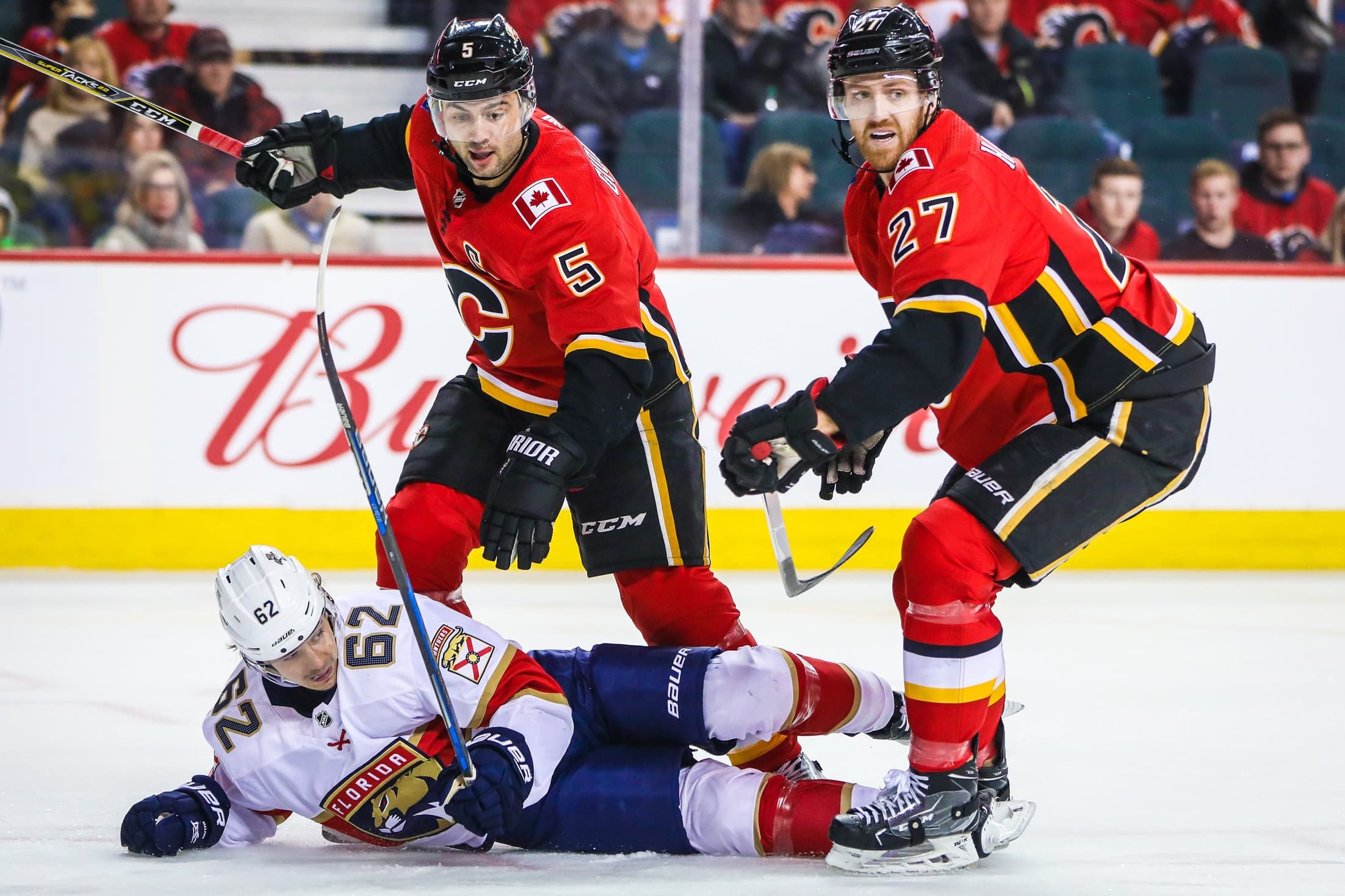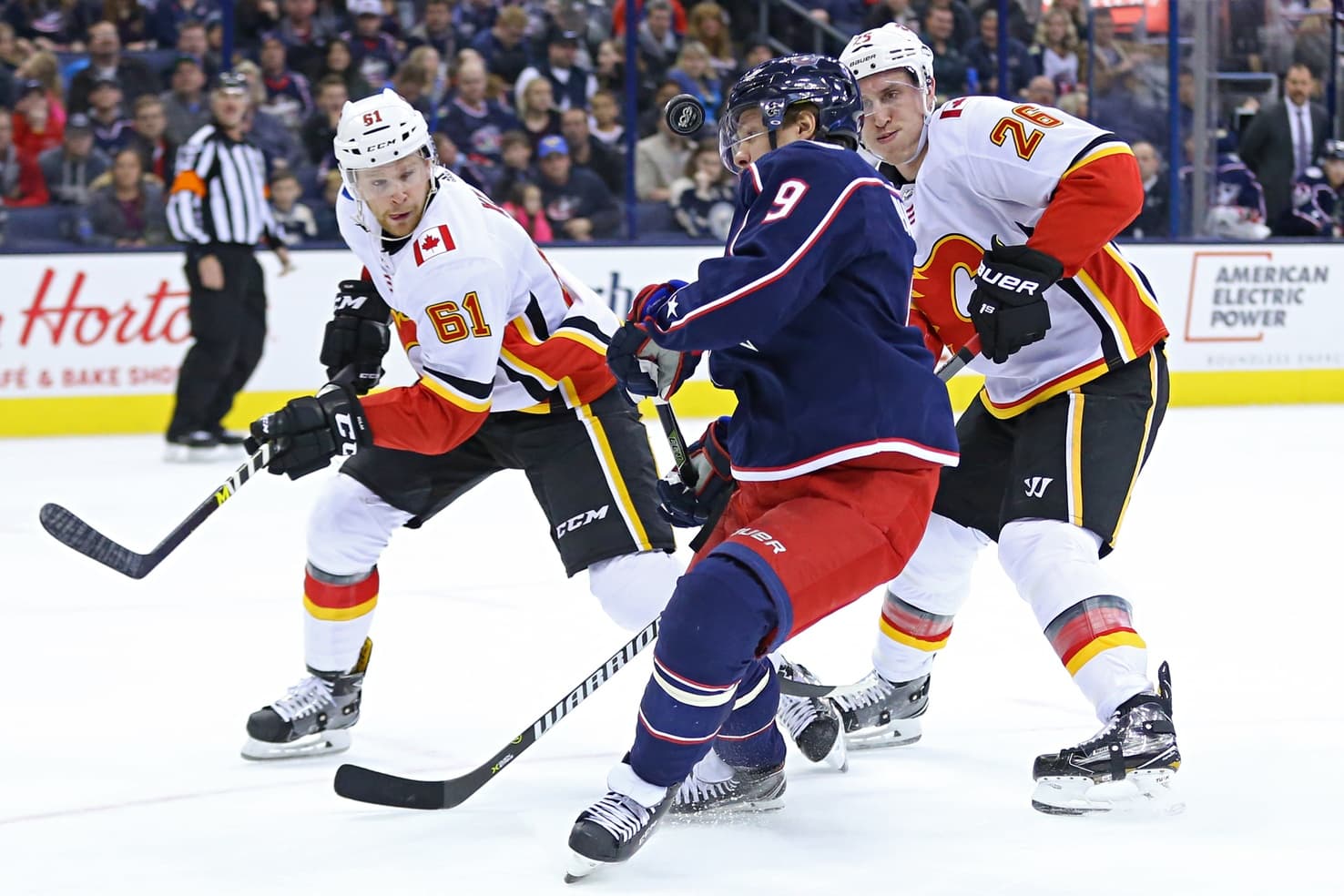Nation Sites
The Nation Network
FlamesNation has no direct affiliation to the Calgary Flames, Calgary Sports and Entertainment, NHL, or NHLPA
Giordano and Hamilton head and shoulders above the rest

Photo credit: Sergei Belski-USA TODAY Sports
Mar 30, 2018, 12:00 EDTUpdated: Mar 30, 2018, 04:05 EDT
With so much negativity surrounding the Flames currently, here’s a positive for you: this team’s top pairing is having another stellar season. After going through our report card exercise at forward earlier this month, our look at the blueline is a little more stark. Calgary’s top pairing has been very good, but the drop off from there has been significant.
FIRST PAIRING
Mark Giordano-Dougie Hamilton
GP | TOI | CF% | GF% | OSZ% |
78 | 1182:49 | 58.6 | 52.5 | 54.4 |
For a second straight year, the pairing of Giordano and Hamilton is one of the league’s best at both ends of the ice. First off, no pairing in the league has spent more time together at five-on-five than these two have this season.
In fact, Hamilton and Giordano have basically been stapled to one another since the early stages of the 2016-17 season; only the top duos in Columbus (Seth Jones and Zach Werenski) and San Jose (Marc-Eduoard Vlasic and Justin Braun) have spent more time together over the last two years.
But Giordano and Hamilton haven’t just spent a lot of time with one another, they’ve excelled together. For a second straight year they’ve posted the league’s top possession rate as a pairing, and have actually boosted it a couple points from last year’s 56.6%. Without heavily tailored offensive minutes, all these two guys have done is drive play this season.
Offensively, both have gotten the job done. Hamilton co-leads NHL defencemen with 16 goals while Giordano sits tied for 11th with 13; Hamilton also ranks third overall in goals-per-60 at .57, trailing only Boston’s Torey Krug. It’s tough to quarrel with what these two have done at the offensive end of the ice.
Hamilton and Giordano have done the job at the other end, too. While not hammered with defensive starts, this pairing averages around 17 minutes of five-on-five time each night against top opposition. To have a positive five-on-five goal differential considering the difficulty of their minutes is impressive and certainly helps dispel any “poor defensively” narratives that may exist.
I’m always happy to push back on the “Dougie’s soft and defends poorly” train of thought, too, because it’s just not true. Yeah, he isn’t overly physical and, sure, he’s made mistakes in his own end, but that happens with every single top pairing defender.
For whatever reason, though, the confirmation bias with Hamilton is high and reminds me a lot of Jay Bouwmeester’s time with the Flames. The reality is, Hamilton is +5 at five-on-five, which is top five on the team, and has contributed positively far more than he has negatively.
Finally, what really seals this pairing’s high grade is how much better they make one another. Giordano and Hamilton make up a true pairing and are better with one another than they are without, as the five-on-five WOWY stats below flesh out, courtesy Natural Stat Trick.
State | TOI | CF% | GF% |
Together | 1182:49 | 58.6 | 52.5 |
Hamilton without | 144:33 | 52.9 | 50.0 |
Giordano without | 137:09 | 53.9 | 45.5 |
Grade: A. No one has spent more time together this season than Giordano and Hamilton have, and there’s a good reason for that. This is one of the NHL’s top defensive pairings and they’ve carried a massive amount of Calgary’s blueline load this season.
SECOND PAIRING

Sergei Belski-USA TODAY Sports
T.J. Brodie-Travis Hamonic
GP | TOI | CF% | GF% | OZS% |
69 | 1042:16 | 51.3 | 45.2 | 50.5 |
When Hamonic was acquired from the New York Islanders last summer, it was with the expressed goal of pairing him with Brodie. The Flames paid handsomely for Hamonic’s service, giving up a much discussed first round pick, minus lottery protection, and a pair of seconds. Knowing the results and expectations, this pairing hasn’t lived up to the hype.
From an underlying perspective, Hamonic and Brodie have been passable if not outstanding. They haven’t driven play like the top pairing has, which is disappointing. Hamonic has never put up counting numbers at a high rate, so I wasn’t looking for a ton of offence from these two, but I was expecting them to contribute to the team’s overall structure a little better.
Despite their struggles, though, they’ve been deployed in a primary role all season long. One of my biggest criticisms of this coaching staff is player deployment, and this is a good example. Brodie, who’s hurt now and likely done for the season, and Hamonic (now also injured), have been relatively ordinary, yet have averaged more five-on-five ice time than both Giordano and Hamilton.
Furthermore, the second pairing has regularly seen similar, if not more difficult, opposition as the top duo has, which is confusing. As a pairing, Brodie and Hamonic are -7 at five-on-five and have made numerous miscues defensively that have led directly to chances and goals. With the way they’ve played, they should be getting significantly less ice time than Giordano and Hamilton, especially at even strength, but that just hasn’t been the case.
It has been a rough go for Brodie this season, and this is likely his worst as a full-time NHLer. While Hamonic has struggled in year one, Brodie looks like he’s fighting it more and it’s hard to pinpoint why. Is he just that much better on the right side? Did Giordano prop him up that much? I don’t know the answer, but the WOWY numbers below paint an interesting picture.
State | TOI | CF% | GF% |
Together | 1042:16 | 51.3 | 45.2 |
Hamonic without | 198:16 | 52.3 | 53.3 |
Brodie without | 238:25 | 48.7 | 48.5 |
Grade: C-. My grade for this duo would likely have been lower had I taken expectations and Hamonic’s acquisition price into account, but I’m leaving that out. The fact is, Brodie and Hamonic have been a relatively average second unit this season. Hopefully Hamonic’s second year in Calgary is more comfortable and is thus reflected on the ice. Whether or not he’s back with Brodie is anyone’s guess.
THIRD PAIRING

Aaron Doster-USA TODAY Sports
Brett Kulak-Michael Stone
GP | TOI | CF% | GF% | OZS% |
66 | 598:09 | 50.6 | 50.0 | 52.3 |
As a pairing, Kulak and Stone haven’t been awful, but they also haven’t been particularly strong. Average is probably the best word to describe them, which is usually passable for number five and six defencemen. The fact Calgary’s second pairing has struggled, though, trickles down a little to what we’ve seen from Kulak and Stone.
Stone is the more experienced of the two and has two years remaining on a contract that carries a $3.5 million cap hit. The organization appreciates his physical edge and likes the way he seals opposing players out of the play along the boards.
On the other hand, Stone doesn’t have great foot speed and that limits his effectiveness. While he’s relatively capable inside his own blueline, Stone doesn’t suppress zone entries very well and is average in terms of quelling shot attempts. As such, he’s probably been slotted properly for most of the season.
Kulak has a little more upside at this point and he’s shown some real flashes. In a lot of ways, he’s kind of the opposite of Stone, in that skating his one of Kulak’s strongest attributes and allows him to step up on zone entries much more effectively. Now completing his first full season in the NHL, Kulak hasn’t done anything to set himself back for next season.
The future of this pairing is what really interests me. At 24, Kulak is still relatively young and, more importantly, very affordable going forward. Even with players like Juuso Valimaki and Rasmus Andersson potentially being ready for next season, there’s no reason for Kulak not to be part of this mix for the foreseeable future. Cheap and effective is a great mix to have, especially on a third pairing.
I see Stone’s future a little differently, though. Trading him this summer seems like a sensible, and somewhat likely, proposition. While I don’t think the Flames would be getting a huge return, Stone could still fetch them a mid-round draft pick; clearing a space for Andersson, and the $3.5 million in cap space, would be the added benefits.
Grade: B-. As third pairings go, Stone and Kulak have been okay this season. They don’t see a lot of five-on-five ice time and rarely see anything but bottom six forward opposition. What this duo looks like next year is a different story, because Kulak and Andersson at a combined, say, $1.5 million looks pretty good.
Breaking News
- Scotia Place: a street-level look at December construction progress
- Beyond the Boxscore: Flames come out swinging in big 6-3 win over Golden Knights
- Rasmus Andersson on remaining a Flame: ‘It takes two to tango’
- Ryan Lomberg’s big goal and big fight highlight Flames win over Vegas
- Instant Reaction: Flames overwhelm Vegas early, hold on for win
